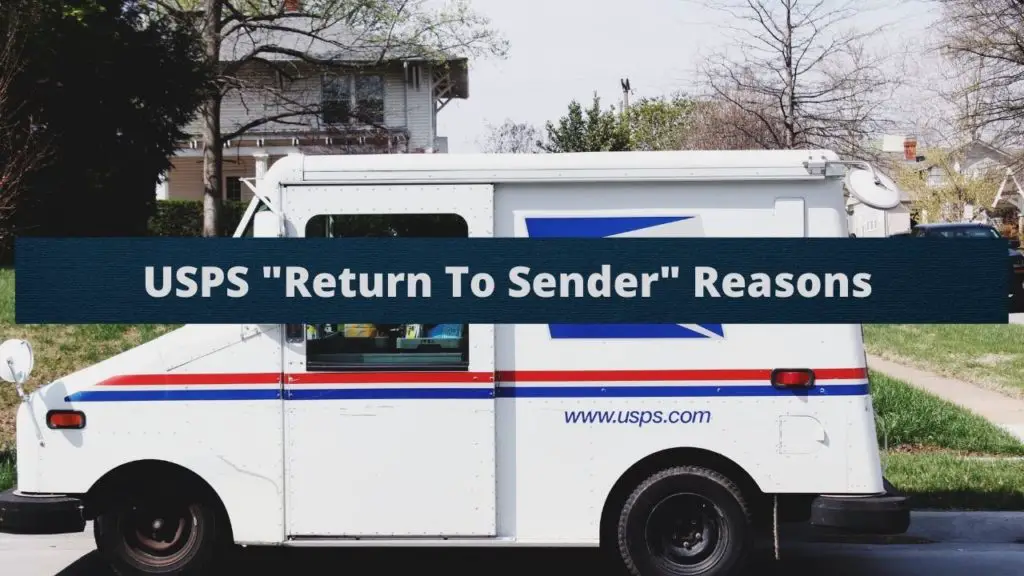Have you ever run into issues with getting mail delivered? This happens occasionally and it is an extremely frustrating occurrence, so you might be looking for a way to resolve it.
There are quite a few reasons that mail gets returned to the sender, including a poorly written address, missing information, failure to deliver, or because the recipient refused to accept the mail. All of these will result in USPS marking the mail as “return to sender” and shipping it back to the person who originally sent it.

Why Did USPS Return To Sender?
USPS will return mail to the sender for quite a few different reasons, and you may be running into any of these problems, so let’s explore them in more detail.
1. Address is not legible
The commonest reason that mail gets returned to the sender is that the address on the envelope is not legible.
USPS will make reasonable efforts to determine the intended address, but if the company is unable to do so, it will simply mark the envelope as “return to sender” and ship it back rather than risk delivering it to the wrong address.
This allows the sender to correct or clarify the address and re-send the item, rather than risking it being delivered to the wrong person.
2. Information missing from the address
Secondly, mail may be returned to the sender because there was crucial information missing from the address.
If, for example, you forget to include the house number or the zip code, it may get returned to you.
Often, postal workers will catch this when you are attempting to send the mail and ask you to correct it, but if this doesn’t happen, the mail will be returned when the omission is noticed.
This could be at any point in the mail’s journey, depending on how major the omission is.
3. USPS has failed to deliver multiple times
Another reason for the mail being returned is that USPS has failed to deliver it multiple times.
If, for example, a package has been sent that requires a signature and they cannot contact anyone at the address, it will be returned.
Postal workers will make two delivery attempts before returning the package to the post office.
It will usually be held there for a certain number of days so that the intended recipient has an opportunity to collect it, but if they don’t pick it up, it will then be mailed back to the sender.
4. The recipient has refused to accept it
Finally, mail may be returned to the sender because the recipient has refused to accept it.
This usually only happens if it has been sent to the wrong house and the person it was intended for has moved away.
How To Avoid Mail Being Returned To Sender?
The best way to avoid mail being returned to you if you’re sending it is to make sure that the address is clearly legible and written in full.
You may find that it helps to print the address, rather than hand-writing it, as this ensures it’s easy to read.
If you have used a pen or ink that will smudge, cover the address with a piece of clear tape to prevent it from getting wet as it travels.
You should also make sure that the address is correct and has been written out in full.
It may help to enter the address into online searches to ensure all the information is included and has been spelled correctly.
USPS provides a service for this, but there are many others that will help too. Double-check all addresses before adding them to your packages and if in doubt, clarify with the intended recipient.
This should resolve any issues with deliveries being sent to an outdated address, too.
You can also ask the USPS postal worker to check the address when you mail the item if you want.
Finally, make sure you tell your recipient when they should expect delivery to arrive.
This will help them to organize their schedule so that they are at home, or at least let them know to look out for a delivery card. They can then collect the package at a time that suits them.
Conclusion
The USPS “return to sender” is an annoying issue to encounter, but you can minimize the risk of it occurring by always checking addresses are correct and writing them out clearly.

Martha had a chance to work for such major companies as USPS and FedEx, where she gained a lot of experience and learned quite a few nuances when it comes to handling mail and packages. Now she is a freelance writer who specializes in the logistics industry.
